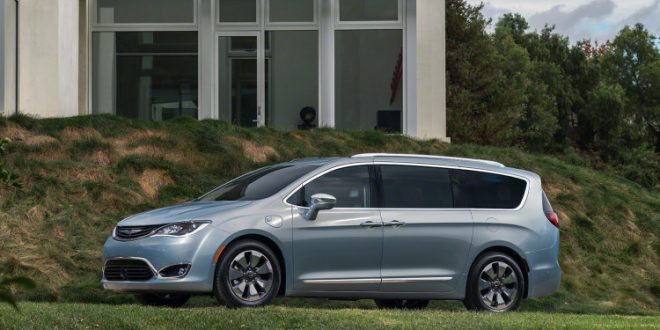This is probably the biggest change in Chrysler minivans since their 1983 launch.
The combination of an seven-seat vehicle with usable electric range will be appealing enough for families and others who like the utility, capacity, and ease of entry that minivans offer.
The redesigned V6 gasoline engine is the most powerful for any minivan, with 287 horsepower and 262 pound-feet of torque. That compares with the Honda Odyssey’s 248 horsepower and 250 pound-feet (rated at 19 city, 28 highway), and the Toyota Sienna’s 266 hp and 245 pound-feet (18 city, 25 highway). It includes two-step variable-valve lift (VVL), cooled exhaust-gas recirculation (EGR), and other improvements over past models. Underneath the mild horsepower gain is 11% higher torque in the 2,000-4,000 rpm range.
Despite the increased power and feature set of the engine, it weighs four pounds less than the prior generation — including 13 pounds of new content — weighing in at 326 pounds. This included thin-wall die-cast components, a lighter windage tray and oil pan (now single piece), and cutting the sump from a six-quart fill to a lower-cost and lighter-weight five-quart fill. The latter is handy for people who buy their own oil, since the five-quart container is a bargain compared with single quarts.
The crankshaft’s main bearings and pins were trimmed, cutting weight and friction.
Standard engine stop-start (ESS) systems are a “late launch” feature. It includes a high-speed, high-durability starter that reduces crank time. Acceleration is always aligned with driver inputs. Passive accelerator application is met with measured throttle response; hard inputs trigger aggressive starts. The system, which can be shut off, works this way:
When the minivan stops, fuel flow is cut; higher-capacity batteries maintain in-cabin systems.
When the brake pedal is released, the engine restarts and the transmission is engaged.
The nine-speed gearbox has a rotary shifter on the center console, saving space and easing use. The compact ZF-based transmission has a wide 9.81 ratio spread which increased both acceleration and economy. The low 4.70 first gear helps launches; small ratio steps for mid-range gears help smooth out shifts. In higher gears, engine speeds can be cut, lowering noise and fuel use. Despite this, it’s about the same size as its six speed predecessor, thanks to nested carriers and the use of dog clutches. Both dog clutches and spline engagements are relatively free from friction losses, for highier efficiency.
With either powertrain, the engine and transmission assemblies are mounted with hydraulic-elastic mounts, and a torque control elastomeric mount bridging to the front suspension cross member. Powertrain mounts are on the right to cut noise and reduce shaking from road bumps; the hydraulic-elastic mounts dampen low-frequency, high-amplitude motions, with the hydraulic portion tuned to dampen engine oscillations (cutting “after-shake” from bumps).
Agencies/Canadajournal
 Canada Journal – News of the World Articles and videos to bring you the biggest Canadian news stories from across the country every day
Canada Journal – News of the World Articles and videos to bring you the biggest Canadian news stories from across the country every day



